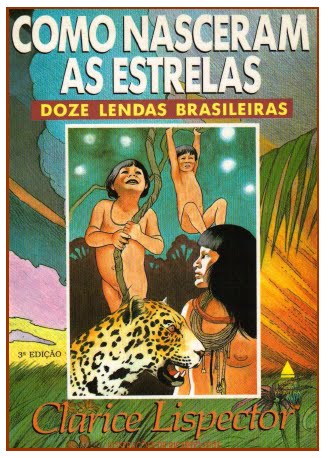Anomalous among Clarice Lispector’s children’s works, Como nasceram as estrelas (How the Stars Were Born), twelve Brazilian legends published in 1987, bring together narratives inherited from tradition and reworked by the writer. The texts were commissioned by the toy factory Estrela for its calendar; thus, each story is related to a month of the year, and the first one gives the work its title. All texts are short, at the most two pages, which seems to be derived from a standard format from the work’s commissioner. Although born of popular literature, the author shapes the legends and imprints her signature by assuming a “self” that is not content with just being a storyteller but becomes a commentator and articulator of ideas. The style of communication, typical of orality, finds firm ground in the narratives, with the addition of intrusions: “Is the moral of this story that good always wins? Well, we all know the answer is not always. But let’s make do the best we can and try to be good and keep a clear conscience.” The pact of interpretation in the sphere of myths puts into play a harmony between text and reader by establishing simple forms and collaborating in the anchoring of the Brazilian imaginary. The tales and myths, pertaining to different regions of the country and derived from different cultures, culminate in December with “Uma lenda verdadeira” (A True Legend), which presents the birth of Christ, narrated with simplicity and lyricism. In all other narratives, the apparently simple expression, the constant interference of the narrator and, above all, a peculiar way of looking at childhood, predominate. The following folkloric episodes are part of the volume: the party in heaven, which is attended by the frog and the vulture; the history of the uirapuru; adventures of Malazartes; Yara’s narrative; a party in the woods, which results in the animals’ losing their speech; the essence of Curupira; the Negrinho do Pastoreio (Little Black Boy from the Pasture); Saci; the tortoise’s cracked shell; the appearance of the animals. A slow pace is evident in the constitution of the narratives; a docile, benevolent storytelling, as one should speak to children, without using resources that infantilize. The moralizing closure, common to folkloric texts and fables, appears out of place, reorganized by Lispector’s writing. Such is the case, for instance, in the legend of Yara, which has as a closing: “This story is no joke. Let certain men beware.” And in the enchanted bird, Uirapuru, in which the narrator concludes with humor: “How did it get around that the uirapuru bird brings good luck? Ah, I have no idea, but it’s really true!”
ByRosa Gens

